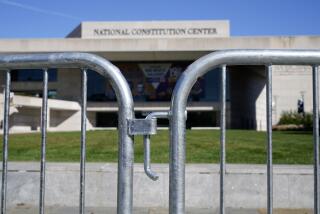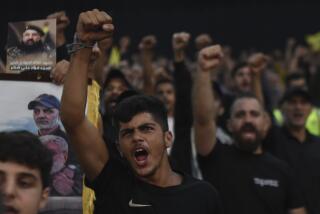Israel Turns to Rubber-Coated ‘Marble’ Bullet
- Share via
JERUSALEM — Israel’s army has introduced a new bullet designed to reduce fatalities among rebellious Arabs fighting Israeli occupation in the West Bank and the Gaza Strip, but like other such innovations, the bullet is proving to be as deadly as regular ammunition.
The bullet, actually a cluster of them launched from a rifle-borne canister, is round, slightly larger than a gum ball and made of metal surrounded by a thin, black rubber membrane. It shows up on X-rays as a white disc; Palestinians call it “the marble.”
During the past five days, the bullets have killed two young Palestinians, Arab physicians reported. Another boy, age 17, lay unconscious at Mokassed Hospital in Jerusalem on Sunday with one of the heavy bullets imbedded in his brain as doctors tried to figure out how to remove it.
Bullet Drifts Deeper
“It is very hard to get it out. We operated once, but the bullet drifted deeper in the brain as we worked,” said Dr. Walid Elian, a physician at Mokassed. “We are waiting to see if there is a way to keep it in one place. Perhaps with a magnet.”
Aware that use of the bullet has resulted in deaths, army spokesman Raanan Gissin defended its use. “We are conducting tests all the time to find out how to reduce fatalities,” Gissin said. “We think when this ammunition is used properly, it will reduce deaths. This bullet is just supposed to knock out the target.”
The introduction of the bullet is the latest Israeli effort to find, through technical means, a way to forcefully subdue the Palestinians while not crossing some undefined threshold of brutality. Israel’s image has suffered both at home and abroad during the 13-month Arab uprising as casualties in the occupied territories have mounted.
In the course of the intifada, as the uprising is known in Arabic, about 340 Palestinians have been killed by soldiers. Since the first of the year, 10 have been shot to death. The new rubber-coated bullet is supplementing the use of regular steel-jacketed lead bullets and so-called plastic bullets, which are really made of a plastic-and-metal blend.
The new bullet is an “improved” version of a rubber bullet that Israeli troops have been using, Gissin said. The old rubber projectile was really more like a small baton that, when fired from the end of a rifle, tumbled in space until it reached, injured and knocked down the target. It had a range of about 20 yards.
The range of the rubber-coated, metal bullet is greater, Gissin said, although he declined to be specific. “These bullets do not go far, but they spread out over a wider area,” he explained.
The bullet was first used in late November, according to the best available information, but it is not clear how widespread its use is. Such information is considered classified by the army.
Victims Mostly Young
The victims of the bullet so far appear to be mainly young people.
One, an 11-year-old boy from the West Bank town of Tulkarm, died Thursday after one of the new bullets pierced his chest, doctors at Mokassed hospital said. On Saturday, a 15-year-old girl from Nablus died when the rubber-coated bullet pierced her skull. The Jerusalem Post reported that the girl was shot when she joined several women in trying to stop soldiers from beating an Arab youth.
Marwan Mugari, the unconscious teen-ager currently under care in Mokassed, was shot last Wednesday in the Nusseirat refugee camp in the Gaza Strip, doctors said. Mugari was wounded when he poked his head out the door during a curfew, according to an account given by his cousin, Mohammed Mugari.
“The marble is still in his head,” Mohammed said in halting English. “Every time he moves, it does more damage.”
Fits and Starts
Israel’s attempts to find an intimidating yet less deadly way to put down the uprising have suffered fits and starts throughout the conflict.
At one point early last year, Defense Minister Yitzhak Rabin condoned beatings of rebellious Arabs and then, under pressure, retracted the policy. Rules for firing on protesters and rioters, at first restricted to occasions when a soldier’s life was in danger, were relaxed late last summer with the introduction of plastic bullets.
The plastic bullets were billed as having a shorter range and being less lethal than regular rounds. But fatalities continued. The toll of 31 dead in December was the second highest registered during the uprising; many of the December deaths resulted from plastic bullet wounds.
Another patient in Mokassed, Issa Manasra, 17, will die soon from a plastic bullet wound to the heart, doctors said. He lost large amounts of blood after he was shot at the Bani Naim refugee camp. His brain died even though his heart beats stubbornly on, the physicians explained.
3 Factors in Fatalities
Army spokesman Gissin attributed such fatalities to three factors. First, he said, the Palestinians have stepped up the pace of violent protest. Secondly, “friction,” which he described as a kind of panic that causes a soldier to fire wildly or at close range, sometimes ends in Arab deaths.
Finally, “improper use” in a willful manner, perhaps by firing very close to a victim, undercuts the official policy of reducing fatalities, Gissin said. “Only in the third case can we do anything to control the problems,” he added, pointing out that soldiers found to have misused their weapons on purpose can be court-martialed.
Israeli politicians, especially those on the left, have been critical of the continuing casualties, especially after the introduction of supposedly less-lethal plastic bullets.
The Israeli government has rejected the use of riot control equipment and relatively non-lethal ammunition, like birdshot, because it considers the conflict in the occupied territories to be an extension of Arab wars against Israel, which thus must be handled by military means.
More to Read
Sign up for Essential California
The most important California stories and recommendations in your inbox every morning.
You may occasionally receive promotional content from the Los Angeles Times.












